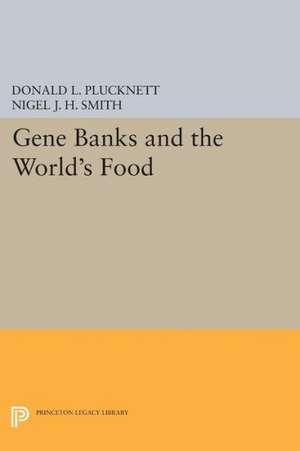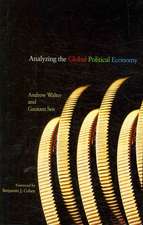Gene Banks and the World`s Food: Princeton Legacy Library
Autor Donald L. Plucknett, Nigel J.h. Smithen Limba Engleză Paperback – 30 iun 2014
| Toate formatele și edițiile | Preț | Express |
|---|---|---|
| Paperback (1) | 420.61 lei 6-8 săpt. | |
| Princeton University Press – 30 iun 2014 | 420.61 lei 6-8 săpt. | |
| Hardback (1) | 836.85 lei 6-8 săpt. | |
| Princeton University Press – 18 apr 2016 | 836.85 lei 6-8 săpt. |
Din seria Princeton Legacy Library
-
 Preț: 437.79 lei
Preț: 437.79 lei -
 Preț: 313.18 lei
Preț: 313.18 lei -
 Preț: 376.99 lei
Preț: 376.99 lei -
 Preț: 363.10 lei
Preț: 363.10 lei -
 Preț: 340.11 lei
Preț: 340.11 lei - 16%
 Preț: 683.63 lei
Preț: 683.63 lei - 16%
 Preț: 2324.11 lei
Preț: 2324.11 lei -
 Preț: 172.27 lei
Preț: 172.27 lei - 16%
 Preț: 882.80 lei
Preț: 882.80 lei - 16%
 Preț: 736.40 lei
Preț: 736.40 lei - 16%
 Preț: 860.09 lei
Preț: 860.09 lei - 23%
 Preț: 780.26 lei
Preț: 780.26 lei -
 Preț: 377.31 lei
Preț: 377.31 lei -
 Preț: 223.24 lei
Preț: 223.24 lei -
 Preț: 362.12 lei
Preț: 362.12 lei - 16%
 Preț: 1452.02 lei
Preț: 1452.02 lei - 16%
 Preț: 915.48 lei
Preț: 915.48 lei -
 Preț: 340.22 lei
Preț: 340.22 lei - 16%
 Preț: 835.12 lei
Preț: 835.12 lei -
 Preț: 266.84 lei
Preț: 266.84 lei -
 Preț: 317.65 lei
Preț: 317.65 lei -
 Preț: 329.09 lei
Preț: 329.09 lei -
 Preț: 265.73 lei
Preț: 265.73 lei -
 Preț: 260.54 lei
Preț: 260.54 lei -
 Preț: 314.84 lei
Preț: 314.84 lei -
 Preț: 402.66 lei
Preț: 402.66 lei -
 Preț: 464.18 lei
Preț: 464.18 lei -
 Preț: 351.09 lei
Preț: 351.09 lei -
 Preț: 483.81 lei
Preț: 483.81 lei - 19%
 Preț: 500.29 lei
Preț: 500.29 lei -
 Preț: 388.44 lei
Preț: 388.44 lei -
 Preț: 328.48 lei
Preț: 328.48 lei - 23%
 Preț: 742.04 lei
Preț: 742.04 lei -
 Preț: 372.92 lei
Preț: 372.92 lei -
 Preț: 328.70 lei
Preț: 328.70 lei - 19%
 Preț: 505.89 lei
Preț: 505.89 lei -
 Preț: 289.17 lei
Preț: 289.17 lei -
 Preț: 446.25 lei
Preț: 446.25 lei - 19%
 Preț: 575.53 lei
Preț: 575.53 lei -
 Preț: 447.20 lei
Preț: 447.20 lei -
 Preț: 484.19 lei
Preț: 484.19 lei -
 Preț: 271.12 lei
Preț: 271.12 lei -
 Preț: 314.46 lei
Preț: 314.46 lei -
 Preț: 362.51 lei
Preț: 362.51 lei -
 Preț: 307.07 lei
Preț: 307.07 lei - 19%
 Preț: 498.46 lei
Preț: 498.46 lei -
 Preț: 272.27 lei
Preț: 272.27 lei - 19%
 Preț: 458.44 lei
Preț: 458.44 lei -
 Preț: 406.20 lei
Preț: 406.20 lei - 19%
 Preț: 515.73 lei
Preț: 515.73 lei
Preț: 420.61 lei
Nou
Puncte Express: 631
Preț estimativ în valută:
80.49€ • 87.40$ • 67.61£
80.49€ • 87.40$ • 67.61£
Carte tipărită la comandă
Livrare economică 22 aprilie-06 mai
Preluare comenzi: 021 569.72.76
Specificații
ISBN-13: 9780691610061
ISBN-10: 0691610061
Pagini: 264
Ilustrații: black & white illustrations
Dimensiuni: 156 x 237 x 14 mm
Greutate: 0.37 kg
Editura: Princeton University Press
Seria Princeton Legacy Library
ISBN-10: 0691610061
Pagini: 264
Ilustrații: black & white illustrations
Dimensiuni: 156 x 237 x 14 mm
Greutate: 0.37 kg
Editura: Princeton University Press
Seria Princeton Legacy Library
Descriere
Descriere de la o altă ediție sau format:
Gene Banks and the World's Food contributes to the crucial debate on how best to preserve some of society's most valuable raw material. The authors also provide an up-to-date report on the status and locations of gene banks, which includes the latest available information on germplasm holdings by crop. They (hen discuss how these holdings are being
Gene Banks and the World's Food contributes to the crucial debate on how best to preserve some of society's most valuable raw material. The authors also provide an up-to-date report on the status and locations of gene banks, which includes the latest available information on germplasm holdings by crop. They (hen discuss how these holdings are being













